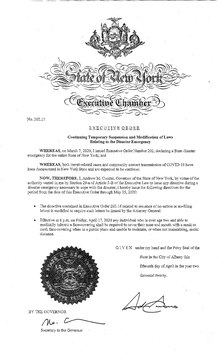
In the United States, a state executive order is a directive issued by a governor that regulates operations of the state government and certain aspects of citizen life.[1] Powers of state executive orders are limited by the respective state constitution and/or executive and state law, and are also subject to the provisions of the United States Constitution and any applicable federal law.[2]
Similar to presidential executive orders, they are subject to judicial review and can be invalidated if determined to violate any statutes or codes by which they are governed. The majority of them carry the force of law[3] and remain in effect until revoked, suspended, canceled, proven unlawful, or expire by a date or condition set forth within itself. In 38 of the 50 states, there is no requirement for orders to undergo administrative procedure, which controls how they are formed and enacted. Six states mandate legislative review, and another six have these requirements only for executive orders of a certain type, like those having to do with the creation of agencies.[4][5][6][7]
- ^ "Governors' Powers & Authority". National Governors Association. Retrieved 2020-06-10.
- ^ Gakh, Maxim; Vernick, Jon S.; Rutkow, Lainie (2013). "Using Gubernatorial Executive Orders to Advance Public Health". Public Health Reports. 128 (2): 127–130. doi:10.1177/003335491312800208. ISSN 0033-3549. PMC 3560871.
- ^ "State and Local Enforcement of Executive Orders on the Rise as Businesses Reopen Across America: Be Prepared to Respond". JD Supra. Retrieved 2020-06-10.
- ^ Washington, 1440 G. Street NW; Skype, DC 20005 202-742-1520 Call with (2014-07-24). "How accessible are executive orders in each of the 50 states?". Sunlight Foundation. Retrieved 2020-06-10.
{{cite web}}: CS1 maint: numeric names: authors list (link) - ^ About Executive Orders of the State of Colorado
- ^ About Executive Orders of the State of Georgia
- ^ About Executive Orders of the State of Washington